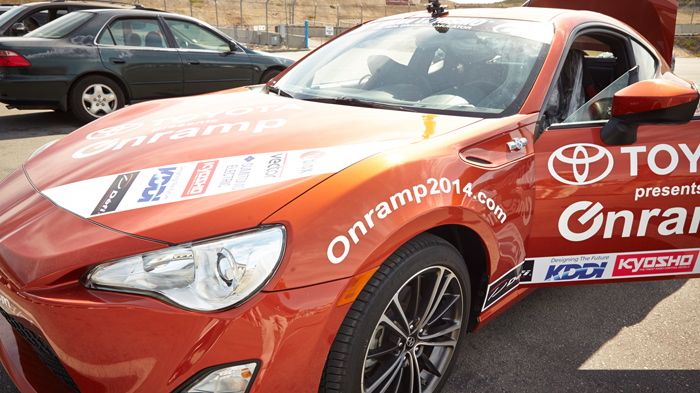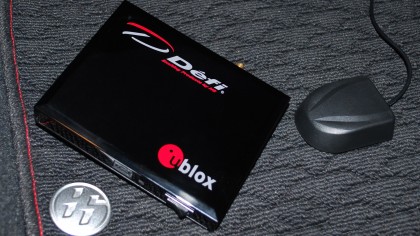Going mobile: Toyota heads to Silicon Valley to rekindle our love of cars
Where car meets driver (and smartphone)

The days of rolling up shirtsleeves to work on a car are a thing of the past for many 21st Century dwellers, with the relationship between man and machine shifting to man and mobile phone.
Toyota is aiming to change that, or at least create a connection between consumer, car and smartphone rather than excluding one for the other. To help do this, the Japanese firm is bringing its connected car initiative to Silicon Valley this weekend with the Onramp 2014 Challenge and Conference, a two-day event in San Mateo, Calif. featuring a 24-hour hackathon, technology fair and business conference attended by the likes of PlayStation, Sony Mobile, GoPro and a host of car-tech companies.
"For me, doing this open innovation project, it was thinking, 'How do we get generations not interested in cars and driving anymore, people who would rather use ride sharing and so forth, how do we get young people interested in driving?'" Toyota's Open Innovation Project Manager Yas Kohaya told TechRadar. "We think cars and driving can still be exciting and fun and we're exploring a new way to bring interest to driving."
The Onramp Challenge is fairly open-ended; developers will have access to the CAN-Gateway ECU, a unit currently available only in Japan that gathers data from a vehicle's sensors, to develop any mobile or web app that enhances the driving experience. The top app will receive a $10,000 prize, and awards will be handed out to the best apps built around the themes of "Safe," "Fun" and "Green."
Several Scion FR-S models will be on hand to test the application creations, professional driver included.
Robert Evans, organizer of the Onramp Challenge, described a number of possibilities for how developers could turn dry car data into a better overall driving experience, such as tying a playlist to the status of a car - whether it's moving quickly or stopped - driving more safely by checking speed and braking, and driving more efficiently by measuring gas efficiency and encouraging better driving skills.
"We even have Kyosho radio-control cars to drive around," Evans added. "There's a way to connect data from Toyota cars to Kyosho cars, so the radio-control cars will replicate whatever the Toyota car is doing. I'm not sure what the practical application of this is, but it's fun and it's creative."
Sign up for breaking news, reviews, opinion, top tech deals, and more.
The CAN-Gateway ECU was developed for the FR-S, but it is car agnostic. Developers can bring any device they like to the event, including Android Wear smartwatches, and connect it to any service they choose.
Adopting a start-up approach
Toyota is one of the world's largest car brands and is famous for its safety and efficiency, so hosting an event that embraces the Silicon Valley's start-up culture seems at odds with the firm's starchy reputation.
"Toyota, as a whole, we're very conservative, very concerned about safety and reliability," said Kohaya. "Not everyone in the company is thinking, 'How do we leverage this new technology?' But we do have people in the company who think differently, and I'm here to support that."
One such person is Tetsuya Tada, chief engineer of the Scion FR-S and creator of the CAN-Gateway ECU. Kohaya relayed that Tada developed the FR-S in 2007, right when the iPhone was coming out. Tada, who owned a software company before coming to Toyota, witnessed a new culture begin to emerge. He wanted in.
"He wanted to come up with a way to connect the real world of cars to the virtual world of phones," Kohaya said.

Evans comes from the Silicon Valley side, where turnaround is quick and trying and failing encouraged.
"That Silicon Valley approach doesn't quite fit in the world of cars, but we want to import the benefits of that into the safer and more regulated world of cars," he said.
"Most major auto companies are here in Silicon Valley," he continued. "We're trying to make connections with start-ups, where development lead-time is quite different. Where it takes 3-4 years to develop a new car, even one year in Silicon Valley is too long."
Kohaya added: "We're trying to make the connection between the start-up world and the automotive world, and I don't think anyone has figured out the formula. Toyota's approach is to be here, bring our own technology, bring our own cars, get Silicon Valley people in the cars, open it up to them and make something that is interesting to them. We want to open that connection. We're trying different approaches to see what works."
Playing with the big boys, too
Recent months have seen the introduction of Android Auto and Apple CarPlay, marking the entry of tech's heaviest hitters into the connected car space.
"[Google and Apple making connected car solutions] has an impact because consumers want to have that same experience on their smartphones as in their car, and we just don't have that now," Kohaya said. "Toyota and most other companies are trying to figure out how to make a more seamless experience in the car."
He noted Toyota is addressing the problem with multiple options, including engaging with Apple and Google to provide a better in-dash navigation experience, though he's not involved in that particular project.
"In this testing space, we'll continue to offer multiple choices because that is the best for consumers," he said.
For more on the Onramp 2014 Challenge and Conference, visit www.onramp2014.com/ and follow @OnrampEvents on Twitter.
- Know who'll be at CES 2015? Toyota, that's who

Michelle was previously a news editor at TechRadar, leading consumer tech news and reviews. Michelle is now a Content Strategist at Facebook. A versatile, highly effective content writer and skilled editor with a keen eye for detail, Michelle is a collaborative problem solver and covered everything from smartwatches and microprocessors to VR and self-driving cars.